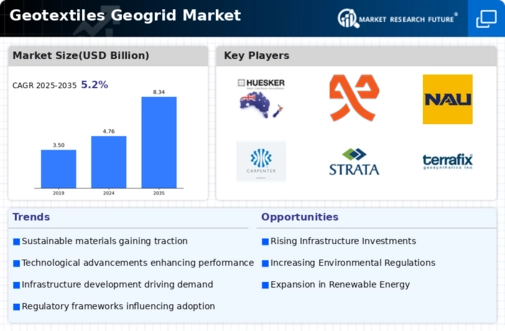Market Growth Projections
The Global Geotextiles Geogrid Market Industry is projected to witness substantial growth, with estimates indicating an increase from 4.76 USD Billion in 2024 to 8.34 USD Billion by 2035. This growth trajectory reflects a compound annual growth rate (CAGR) of 5.23% from 2025 to 2035. The expansion is driven by various factors, including infrastructure development, technological advancements, and increasing environmental awareness. As the market evolves, it is likely to attract investments and innovations, further enhancing the capabilities and applications of geogrids across multiple sectors.
Regulatory Support and Standards
Regulatory frameworks and standards are increasingly supporting the Global Geotextiles Geogrid Market Industry, promoting the use of geosynthetics in construction and environmental projects. Governments are establishing guidelines that encourage the adoption of geogrids for soil stabilization and erosion control, recognizing their benefits in enhancing infrastructure resilience. This regulatory support is likely to facilitate market growth, as compliance with these standards becomes essential for project approvals. The emphasis on safety and sustainability in construction practices suggests that geogrids will play a pivotal role in meeting these regulatory requirements, thereby driving demand in the market.
Rising Infrastructure Development
The Global Geotextiles Geogrid Market Industry is experiencing a surge due to increasing infrastructure development across various regions. Governments are investing heavily in transportation networks, including roads, bridges, and railways, which require robust geosynthetic materials for soil stabilization and reinforcement. For instance, the global market is projected to reach 4.76 USD Billion in 2024, driven by these initiatives. The need for durable and sustainable construction solutions is paramount, as infrastructure projects aim to enhance connectivity and economic growth. This trend indicates a growing reliance on geogrids to improve the longevity and performance of civil engineering projects.
Environmental Sustainability Initiatives
There is a notable shift towards environmental sustainability within the Global Geotextiles Geogrid Market Industry. As awareness of ecological impacts increases, construction and civil engineering sectors are adopting geosynthetic materials that minimize environmental degradation. Geogrids, known for their ability to reduce soil erosion and enhance vegetation growth, align with these sustainability goals. This trend is likely to bolster the market, as companies seek eco-friendly solutions that comply with regulatory standards. The anticipated growth from 4.76 USD Billion in 2024 to 8.34 USD Billion by 2035 reflects a commitment to sustainable practices, potentially increasing the demand for geogrids in various applications.
Growing Demand in Agricultural Applications
The agricultural sector is increasingly recognizing the benefits of geogrids, contributing to the expansion of the Global Geotextiles Geogrid Market Industry. Geogrids are utilized in soil stabilization and erosion control, enhancing agricultural productivity and sustainability. Farmers are adopting these materials to improve land management practices, particularly in areas prone to soil degradation. This growing demand is indicative of a broader trend towards integrating geosynthetics in agriculture, which may lead to increased market penetration. As agricultural practices evolve, the reliance on geogrids is expected to rise, further supporting the market's growth trajectory.
Technological Advancements in Geosynthetics
Technological innovations are playing a crucial role in shaping the Global Geotextiles Geogrid Market Industry. Advances in material science and manufacturing processes have led to the development of high-performance geogrids that offer enhanced strength and durability. These innovations enable geogrids to withstand extreme environmental conditions, making them suitable for a wide range of applications, from road construction to landfill stabilization. The market is expected to grow at a CAGR of 5.23% from 2025 to 2035, indicating that ongoing research and development efforts will likely continue to drive demand for advanced geosynthetic solutions.



















